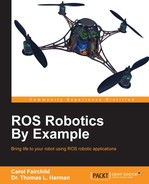Some quadrotors can be dangerous if flown carelessly. Depending on the size, weight, and power of the quadrotor, collisions with property, people, or pets can cause serious damage. At the very least, crashes of your quadrotor can damage the craft and end your flying career until you purchase a new one or repair the damaged one.
Although this book is not about flying quadrotors, we believe that some discussion of good flying practice is necessary. The discussion will be particularly helpful to new pilots.
Since this chapter is not about flying the quadrotor but how ROS is used to control the craft, we will refer you to various websites on the Internet. Searching for How to fly a quadrotor or How to fly a quadcopter will yield over one million hits. Better to refine the search and specify the type of quadrotor you wish to fly.
Many websites present articles on flying quadrotors. For example, various tutorials are available at the following websites:
There are also many YouTube videos showing quadrotor or quadcopter flying techniques.
Some of the things that should be considered before and during flight are as follows:
- Testing your quadrotor
- Preflight checklist
- Safety and dangers
- Rules and regulations
When your new quadrotor first arrives, it is natural to wish to begin flying immediately. Our suggestion is to be patient and take time to familiarize yourself with the quadrotor and its flight controller. We found that removing the propellers to test the quadrotor indoors was a good way to understand the craft and its controller without any danger of crashes.
Also, some practice on a simulator such as Hector (described later) will help you understand the flight controls. Remember that the controls will be reversed for direction and pitch control when the quadrotor is flying towards you, as compared to control when the craft is flying away from you. A little time using the simulator will improve your flying ability.
Any good pilot follows a checklist before flight. Some of the basics are as follows:
- Check that the quadrotor is not damaged and its battery is charged.
- Make sure that the flight controller is disarmed so the quadrotor cannot take off until you are ready.
- Make sure the area for flight is clear of obstacles and people.
- When flying the quadrotor, always be aware of the surroundings and keep the quadrotor is in sight. Flying over people or their private property without permission is typically illegal in most countries.
- When flying in a public area, inform the police or the appropriate authorities that flights will take place. Be sure to keep the craft well away from buildings, trees, and people.
- If flying using GPS, be sure the GPS satellite signals are locked on before flying. It could take several minutes for the on-board GPS receiver to get the signals from at least four satellites.
When you are learning, start your flights outdoors in a light wind or no wind condition. A high wind can cause the quadrotor to fly out of control. Remember that if the battery fails, the quadrotor will not glide but will fall straight down. Keep aware of the battery percentage charge and bring the quadrotor to its landing point when the battery charge is low, below 20 percent to be safe.
Tip
Use caution when flying quadrotors
Motors can fail and propellers can break due to a hard landing. Communication between the ground-based control device and the quadrotor can be interrupted or lost. If the motors or propellers are damaged, controlled flight may be impossible. If the battery drains in flight, the quadrotor will fall to the ground unless it has a fail-safe mode that returns the craft home when the battery is low or communication with the quadrotor is lost.
Quadrotors are considered drones and it is likely that these unmanned aircraft systems will be regulated heavily in the future. In the United States, the Federal Aviation Administration (FAA) regulates flights and requires registration of some craft including quadrotors based on weight of the craft. Around the world, the International Civil Aviation Organization (ICAO) works with many countries to regulate flights.
The FAA has issued guidelines for flying craft in the general category of Model Aircraft with the following guidelines quoted from the website: https://www.faa.gov/uas/model_aircraft.
- Fly below 400 feet and remain clear of surrounding obstacles
- Keep the aircraft within visual line of sight at all times
- Remain well clear of, and do not interfere with, manned aircraft operations
- Don't fly within 5 miles of an airport unless you contact the airport and control tower before flying
- Don't fly near people or stadiums
- Don't fly an aircraft that weighs more than 55 lbs (24.9 kg)
- Don't be careless or reckless with your unmanned aircraft – you could be fined for endangering people or other aircraft
The ICAO website is at http://www.icao.int/about-icao.
You can also read the book Building Multicopter Video Drones, Ty Audronis, Packt Publishing (www.PacktPub.com). The book contains many useful suggestions and safety tips for flying quadrotors.
Be aware that requirements might change and probably will, so keep up with the latest flying regulations for your quadrotor.
